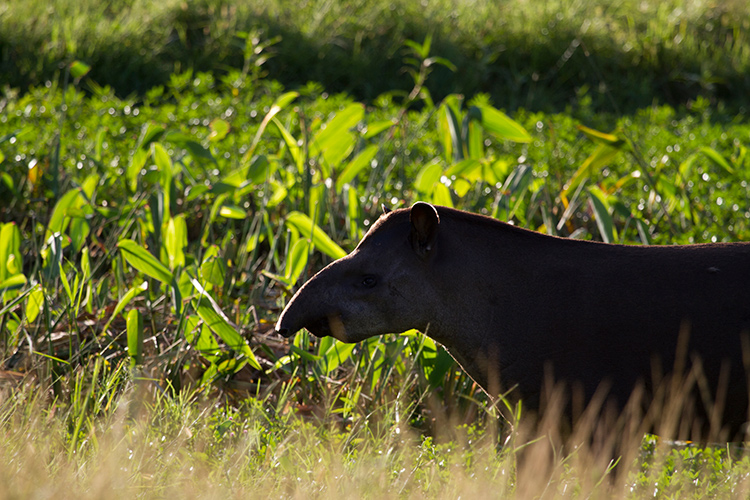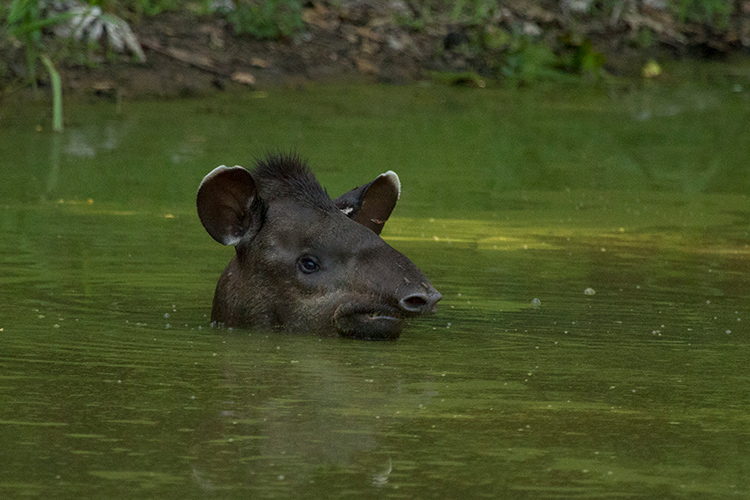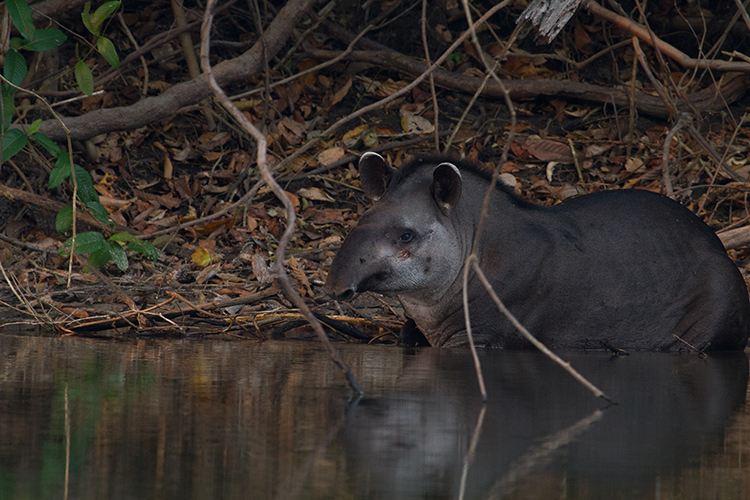Diogo discusses the Tapirapé Project at Caiman Ecological Refuge
Posted by Diogo Lucatelli
in Americas
In this article, Apex field leader Diogo Lucatelli describes his involvement in an ambitious new project to habituate Lowland Tapirs at Caiman Ecological Refuge in Brazil’s Pantanal.
I turned quickly, alarmed by the footsteps, only to find that a Crab-eating Fox—who seemed to be even more alarmed by me—had appeared on the road. From the direction of the noise, I imagined he had spent the day hiding in the pile of debris by the roadside. Those trunks and branches had been dragged and piled there by the guiding team and me after strong winds brought down several trees over the road. “You’re welcome, buddy,” I thought.
The fox trotted eastwards, passing by me, drawn by the freshness of a late winter afternoon in the southern Pantanal. In almost an exact deja vú, his slightly smaller partner came out of their shelter towards the road, and they disappeared. Their night had begun. Bugs and snakes, rabbits and birds, beware! Plus some fruit to balance out their diet. Smart looking creatures.
I’m all alone again. Except for the mosquitoes. They’ve been here since 5pm, and took half an hour to reach their full force. It seems the tinamous and parrots had ceased their symphony in deference to this humming orchestra. I sit quietly amidst this concert, surrounded by a hundred musicians which only stop playing for a few sips of my blood. I sharpen my ears beyond the song to the crickets in the background, playing in resonance. I allow myself to be distracted and amazed by everything, while I am actually looking for only one thing. I listen for buffered footsteps on forest litter, the scrape of a big belly on tall grass, and the occasional branch being broken or leaves being plucked.
The largest land mammal in South America would not walk through thick bush unnoticed. So I wait for its sounds. It has been like this since May, when Caiman Ecological Refuge and Onçafari embraced an old dream I’ve held for a long time: to work with Lowland Tapir habituation at Caiman, and do with that species what we were able to achieve with Jaguars at Caiman—deep knowledge of the species and amazing sightings. Well, there are places to go and see these peaceful giants: Cristalino Lodge at dry season, for instance—one of our destinations on the Apex Brazil expedition—usually produces numerous sightings of these creatures late in the afternoon, refreshing themselves in the water. But I always wanted more than those marvelous yes, but limited views of a tapir’s life.
In many ways, tapirs are shrouded in mystery. Mostly nocturnal creatures, they are solitary, extremely shy, and always feel more comfortable in the concealment of dense vegetation. Sharing habitat with Jaguars and men, they tend to either hide in the bush or stampede their way through it at any sign of disturbance. So, although largely studied with GPS (Global Positioning System) and VHF (Very High Frequency) tracking systems in the many biomes the tapir occurs—from northern South America to northern Argentina and southern Brazil, through Amazonian and Atlantic Rainforests, the Brazilian Cerrado, Chaco and Pantanal—little is known about this animal’s behavior and natural history. Mating system, interactions between conspecifics, seasonal changes in habitat use, and many other questions remain to be investigated. The kind of things you only have an idea about from observing the creature directly in its habitat through generations, but that have never been studied before. The Tapirapé Project —which means ‘the tapir’s path’ in Guarani—carried out by Onçafari and under Caiman’s sponsorship, intends to bring light to these mysteries and make the tapir’s stories part of the guest experience. Fortunately, this is what Onçafari has been doing for ten years with Jaguars, so we knew where to start.
It has been intense. It is the dry season, so I can walk. And there are few things in life I like more than walking in the bush. My mornings are spent reading tracks on the ground, spotting feeding signs and latrines. I combine my tracking observations with my camera trapping results, which allows me to build a picture of how my target animals use the habitat—preferred waterholes, sleeping sites, foraging grounds and trails, and feeding habits—and how these change over time. I am accumulating knowledge for the future in the short and long term.
Earlier this morning I trailed a young male. The previous night he had visited the waterhole and the clay lick beside it, after leaving its bed site not long after sunset. I know this because it passed in front of one of my cameras. I trailed it to a beaten foraging trail, losing it as soon as it started to zig-zag profusely as it plucked leaves and fruits and sprouts, following tasty smells it picked up from far away, always at a slow calm pace. But I picked up the trail again, this time coming back to the bed site not far from the same waterhole.
It has been an hour of waiting by the waterhole now. It is a long shot, but my bet is that Mafí—the young male’s name which means ‘at night’ in the Guató native language—will repeat its ritual. The mosquitoes are mostly gone now—or maybe I just got used to them. Venus goes low in the west and a waxing crescent moon allows me to only see the outlines of the landscape. I don’t swing the spotlight from time to time anymore. I know better now, despite the bitter taste of missing so much due to my deplorable human night vision. Instead, I wait in absolute silence and listen. A bat flies past and a single leaf falls. The air freshens up. A twig breaks. And another. Something in the noises makes me sure it is a large animal, and in South America, that means tapir.
I resist the impetus of shining the light: these are cautious animals, and I learned even the movement of their own shadow may scare them. So I have to be cautious if I want this big boy to become habituated. Experience taught me animals are more likely to accept a slightly disturbing presence if they are engaged in something such as feeding, or bathing, or drinking. What I am hoping for is that Mafí comes to the clay lick. He is a young male, freshly out of his mother’s company and protection, and has been quite loyal to his habits. Now the sounds are soft. It is stepping on sand, not leaves anymore, which means it is at the waterhole area already. I don’t hear a thing though, for too long. The fear of having missed him makes me switch on the torch with a red filter: and to my surprise there he is, at the clay lick.
He is alone, I think. As expected, but it came to me in a more touching way. His perfect gray hide, spotted white, and kept safe for so long by his mother’s protection, now carried the marks of Mafí’s first encounter with a jaguar—deep claw cuts on its rear. We stayed together for ten minutes while I made an effort to be present in movement and noise, but unthreatening and disinteresting, as the habituation process demands. Eventually my cough was too much for him and he moved on to his foraging trail northwards. Into the bush, where I couldn’t follow.
I lost sight of him, but felt pleasure both in the encounter and knowing more or less where the animal was headed. So as I drive back to base, I allow myself to dream, placing my hopes in September when we’ll try to capture Mafí and Kenoti (his already pregnant mother). We’ll install VHF ear tags—never before used with this species—which will allow us to follow, habituate and observe tapirs in a close and intimate fashion, as we’ve never been able to do. One day, we hope to be sharing their stories with you firsthand as we observe the tapirs together.
Join Diogo to discover the wildlife riches of the Pantanal on an upcoming Apex expedition to Brazil.




